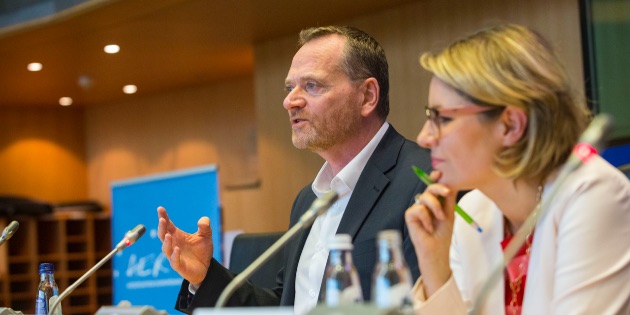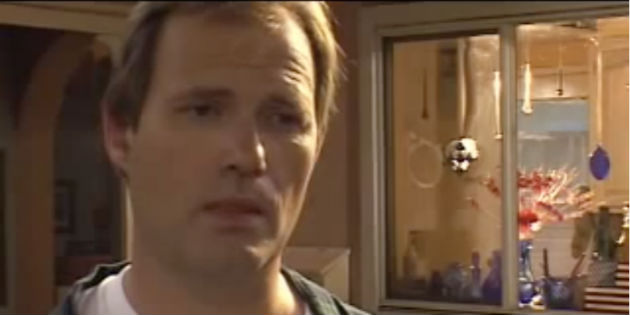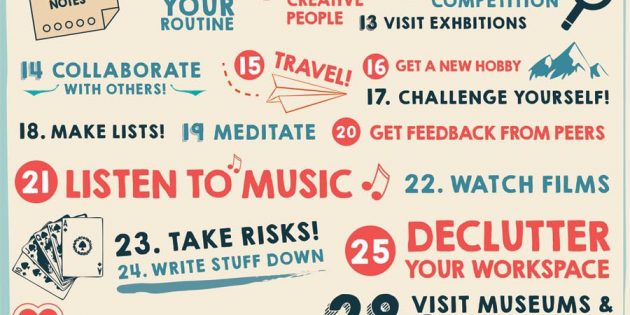I was recently invited to speak at the Association of European Radios Conference at the European Parliament in Brussels, about the key dynamics shaping radio’s future.
The conference theme was ‘Audio Revolution: Radio’s future in an age of tech giants‘.
In their own words, “The Association of European Radios (AER) is a Europe-wide trade body representing the interests of over 4,500 private/ commercial radio stations across the EU28 and in Switzerland.”
I was asked to give a programming perspective in a ten-minute presentation. What follows is a lightly edited version of that presentation:

I Love Radio
I confess. I love radio. So I am delighted to see how resilient and robust it is proving to be.
From a content and creative point of view, I believe radio around Europe is better than ever, and it is good to see how much listeners continue to love it. For example, in the UK today:
- 89% of the population listen to the radio every week
- For an average of 21 hours a week each
In such competitive times, these are impressive figures.
Of course, no one gets a free pass into the future so radio must earn – and fight for – its place. And it’s important it’s a fair fight.
Key Dynamics
From a programming point of view, there are four inter-related key dynamics that will shape radio’s future:
- Competition (not from other radio stations – that’s business as usual – but from other audio services)
- Innovation (responding to increased competition & market changes)
- Regulation (regulation can strangle or super-charge the radio industry)
- Distribution (without a route to listeners, we are talking to ourselves)
Competition
Radio faces increasing and improving competition.
On a macro level we see a new interest in audio. There are more audio services, games, experiences & entertainment competing for ‘eartime’ than ever before.
Podcasts
Podcasts are the new stars of audio entertainment, and podcasts compete with radio for that ‘eartime’.

The podcast statistics are already impressive and continue to grow:
- over 750,000 active podcasts currently available
- over 30 million episodes available up to June this year
But, to take the UK as an example again, right now podcasts have only a 4% share of all audio entertainment. Radio, on the other hand, still has 74%.
This is a PR issue: radio has the listeners, but podcasting has the headlines.
Individual Elements
On a micro level, we see increased competition – an explosion of choice – for individual traditional radio programming elements. To name just a few:
- Travel – Google Maps, Waze, Apple Maps
- News – Google, Apple, Apps
- Weather – Google, Accuweather, Apple
- Personality
- Podcasters
- Youtubers
- Influencers
- Music – Spotify, iTunes, Google Play
Streaming Services
As an aside, it is interesting to note these streaming and download companies have invested heavily in human curation – with people often recruited from the radio industry – as it seems, at this stage, human beings still do a better job of curation than algorithms.
Spotify have recently run a new advertising campaign tapping into the psyche of 35-45-year-olds. It was developed by London creative agency Who What Why. It is a clever and creative campaign that shows smart consumer insight. It was the biggest campaign Spotify have ever run in the UK.

Stationhead
Statonhead is another new actor in the audio entertainment space. The app combines the music from a listener’s Spotify account with live or pre-recorded speech content.
More to Come
And we can expect these new competitors to keep on coming.
It is fascinating to see how, over time, the audio services often become more radio-like with curated playlists, presenters, guests, news & information but – obviously – without the same regulation.
This increased competition forces good Programmers to question every single element that goes into a radio station’s output:
- is it good enough?
- is it (still) relevant?
- Does the listener care?
This is a good thing. It stops radio people becoming complacent and provides increased choice for listeners.
Innovation
Innovation & investment are both key to keeping radio relevant to today’s demanding audiences. Radio IS innovating in many areas, and must continue to do so:
Programming
On the output side, we see innovative brand extensions (both on DAB and online) becoming one of the standard tools for radio stations looking to increase their reach and profile.
For example, Absolute Radio – part of Bauer Media in the UK – has seven brand extensions.

In some dayparts, they have the same live presenter on all seven services simultaneously, playing different music on each one.
On the content side, we see radio stations investing more in top talent and programming ideas:
- Chris Evans joined Virgin Radio UK from the biggest radio show in Europe, on BBC Radio 2
- Similarly, we see other big names on stations all over Europe
- Bigger production teams
- Better competitions
- Better features
- New formats
Community

We also see radio stations continue to innovate as engaged and active members of the communities they serve. For example, in the Republic of Ireland, Cork’s 96FM’s 2019 Radiothon raised an extraordinary €440,451 for local charities and good causes.
Investment
On the technical side we see radio stations investing in:
- DAB & DAB+
- Apps
- Streams
- Smart Speaker Skills – and promoting them to listeners – to make sure radio is wherever the listener is
It is interesting to see a number of NRJ’s new TV creatives puts Amazon’s Alexa centre-stage from the start.
Business
On the business side we see radio stations innovate too:
- Programme their station portfolios in a complementary way
- Find economies of scale
- Invest in key content
- Develop programmatic selling
- Offer better audience targeting for advertisers
- Create new commercial models
Commercial
For example, the Chris Evans Breakfast Show sponsorship with Sky was a unique and creative deal. It combined:
- A unique talent & team
- No ad breaks
- Premium content
This combination creates a seamless flow of entertainment, with an integrated commercial partner who is not only a sponsor of the show but also a supporter and facilitator. Some of the most exclusive and attractive content and competitions were only possible because of this unique relationship.

Bob Suppiah, Director of Promotions and Partnership Marketing for Sky, one of radio’s biggest advertisers in the UK, suggests the unique Sky sponsorship of the Chris Evans Breakfast Show model may help develop new commercial relationships, extending the traditional radio advertising & sponsorship model.
Regulation
Regulation is the price of admission for radio companies: If you’re going to play in a walled garden, then you expect there to be rules about what you can – and can’t – do there.
Regulation can be a powerful force for good or bad. Here are examples of both:
Research repeatedly shows radio is the most trusted of all media. This is for good reason: In most European markets, radio stations are mandated and regulated to be politically balanced.
European radio stations are typically free of the fake news and propaganda that blight so many other old and new media.
On the other hand, in my opinion, content quotas – for example, for news & current affairs, or local music – tie the hands of programmers and undermine radio’s competitiveness.
Content quotas confuse quantity and quality. They misunderstand the pace and needs of a modern audience. They often have unintended consequences. In some situations, they drain resources and drive listeners away from radio.
Let me give you a quick example:
Slovakia
In 2016, Slovakia introduced a domestic music quota of 25%. This probably seemed like an easy way to support the local music industry but, in practice, it’s killing radio for the under 25s.

Since 2016, in just 3 years, all radio reach in Slovakia has fallen from 65% to 60% with most of the losses amongst younger audiences.
We recently completed another music research study there which showed, yet again, that younger Slovakians simply don’t want to hear local music on the radio.
The 25% quota is making the local music industry lazy, and the younger radio stations unlistenable to their target listeners at certain times of the day.
This regulation is driving people from radio to streaming services and other services that don’t face the same old-fashioned and out-of-date approach to regulation.
Distribution
Finally, distribution. Above all else, radio must ensure it is available whenever and wherever the listener wants it. From a broadcast point of view, it’s not as easy as it used to be.
Technology
Radio sets are simply not the devices of choice anymore.
Radio alarms have disappeared from bedsides. Most of us now wake up to mobile phones … and increasingly smart speakers.

Smart speakers and smartphones don’t have FM or DAB chips. Nor do tablets, laptops or desktops.
Cars don’t have a radio front and centre in the dashboard anymore. To find the radio on a Tesla, for example, you must navigate through several menus before you get there.
Despite these technology changes, radio plays a pivotal role in our listeners’ lives and continues to entertain and inform an enormous proportion of the general public every day.
Big Tech
In a non-broadcast environment – and already in Europe we’re up to about 10% of all radio listening done via IP, and this is only going to grow – tech giants control radio’s distribution.

Radio is caught in an impossible situation: it can ignore streaming, and get left behind as IP distribution continues to grow, or fight to be there too, where our listeners are.
This means leaving the traditional regulated broadcast environment for the wild west frontier of tech giants for whom moral and legal responsibilities seem little more than inconveniences.
There are both benefits and the risks to radio from the tech giants but there is no real doubt in my mind: The future of distribution is outside radio’s control and we need someone to control it for us, to ensure it’s a fair fight for the future.
The Bottom Line:
Radio is popular, trusted, responsible, independent, creative and utterly fabulous … radio deserves to be heard.

Thank you so much to AER for the opportunity to speak at the conference, and to spend some time considering some of the more macro themes facing the radio industry in such a dynamic and competitive time.
Thanks to them too for the chance to hang out with the lobbyists, lawyers and strategists from across our industry in Europe. For me, a different tribe from usual and, never-the-less, a hard-working, passionate, and important group of people.





